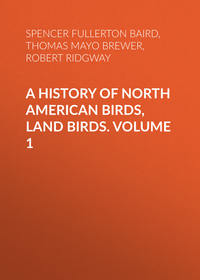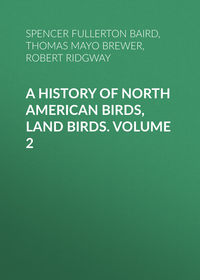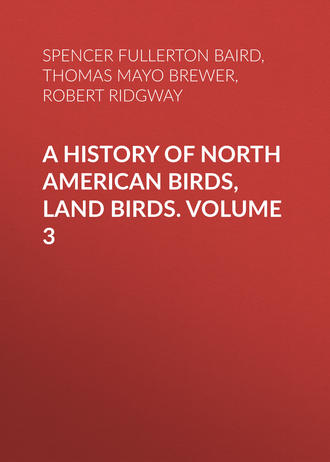 полная версия
полная версияA History of North American Birds, Land Birds. Volume 3
Mr. Dall states that the eggs are usually four in number, of a greenish-white color, and were usually all laid by the first of May. An egg of this bird, obtained by Mr. Dall at Nulato, April 27, 1858, measures 2.28 inches in length and 1.90 in breadth. It is of a rounded-oval shape, and is of a uniform dead-white color, with hardly a tinge of green. Another, obtained by Mr. Charles Pease near the head-waters of the Unalakleet River, measures 2.32 by 1.80 inches, and the ground-color is more distinctly greenish-white. A few small spots of a bronze-brown are scattered in isolated marking irregularly over the egg. Lieutenant Bendire writes that he has found the eggs of this Hawk in Montana; that their number in a set is usually two, and an unspotted white.
Genus ASTURINA, Vieillot
Asturina, Vieill. 1816. (Type, Falco nitidus, Latham.)
Gen. Char. Somewhat similar to Astur, but of much heavier and more robust build; tarsi longer and stouter, tail shorter and less rounded, wings longer, etc. Bill more elongated than in Astur, the cere longer, and the festoon on the commissure more developed; nostril oval, horizontal. Wings rather short, but less concave beneath than in Astur; third to fourth quill longest; first shorter than eighth or ninth; four outer quills with their inner webs sinuated. Tail considerably shorter than the wing, slightly emarginated, the lateral pair of feathers longest. Feet large and robust, when outstretched reaching almost to the end of the tail; tarsi very robust compared to the toes, about one and a half times as long as the middle toe, the frontal and posterior rows of transverse scutellæ very distinct and regular; outer toe longer than inner; claws strong, well curved, but not very acute. Sexes alike in color; old and young plumages very different.

34002, ♀. ½

34002, ♀. ¼
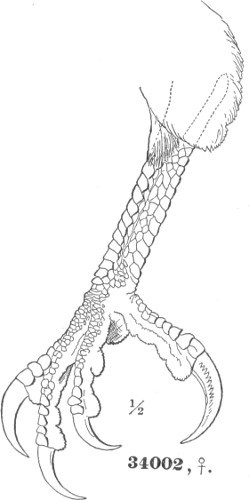
34002, ♀. ½
Asturina plagiata.
This genus is peculiar to tropical America, and contains but a single species, the A. nitida, with its two climatic races, nitida of South America and plagiata of Middle America. The species of Rupornis, Kaup (R. magnirostris and R. leucorrhoa), have been associated with the species of the present genus, but they are very distinct. The genera (or, more properly, subgenera) most nearly related to Asturina are Leucoptrinis, Kaup, of tropical America, and Kaupifalco, Bonap., of Western Africa. The former differs mainly in more or less rounded, instead of emarginated, tail, and in having the old and young plumages similar; the latter in having the posterior face of the tarsus without a well-defined row of transverse scutellæ.
Species and RacesA. nitida. Wing, 9.80–11.50; tail, 6.70–8.00; culmen, .80–1.00; tarsus, 2.50–2.90; middle toe, 1.40–1.75. Adult. Above clear ash, paler on the head and darker on the rump; the general surface with more or less appreciable transverse bars, or indications of bars, of a paler shade, and with darker shafts. Upper tail-coverts immaculate white. Tail deep black, fading into pale grayish-brown at the end, narrowly tipped with white, and crossed by two to three white bands. Lower parts, including the tibiæ, axillars, and throat, regularly barred with deep ash and white, the two colors about equal in extent; chin and crissum immaculate white. Young. Above blackish-brown, variegated with pinkish-ochraceous. Tail umber, tipped with pinkish-brown or dull whitish, and crossed by six to seven narrow bands of black. Beneath white, sometimes tinged with ochraceous; the breast, abdomen, and sides with longitudinal tear-shaped spots of black.
Adult. Upper surface distinctly barred, the lighter bars predominating; the top of the head as distinctly barred as the lower parts. Young. Tibiæ immaculate white or pale ochraceous. Culmen, .80–.90. Hab. South America, from S. E. Brazil and W. Ecuador, to Panama … var. nitida.84
Adult. Upper surface only obsoletely barred, or almost uniform; the top of the head without any bars. Young. Tibiæ transversely barred with dusky. Culmen, .75–.80. Hab. Middle America, north to the southern border of the United States; straying northward in the Mississippi Valley, to Southern Illinois … var. plagiata.
Asturina nitida, var. plagiata (Schleg.)MEXICAN HAWKAsturina nitida, Cass. Birds N. Am. 1858, 35.—Scl. & Salv. Ibis, 1859, 217.—Salv. Ibis, 1861, 68.—Scl. P. Z. S. 1857, pp. 201, 227; 1859, pp. 368, 389; 1864, 178.—Lawr. Ann. N. Y. Lyc. IX, 133.—Owen, Ibis, III, 1868 (egg white). Asturina cinerea, Cass. P. A. N. S. 1855, 283 (not of Vieill.!). Asturina plagiata, Schleg. Mus. Pays-Bas. Asturinæ, p. 1.—Scl. & Salv. P. Z. S. 1868, 173; 1869, 130.—Gray, Hand List, I, 30, 1869.—Ridgw. Am. Nat. VI, July, 1872, 430; VII, April, 1873, 203; (Southern Illinois, August).
Sp. Char. Adult male (51,343, Mazatlan, Mexico; Ferd. Bischoff. “Length, 16.00; extent, 38.00”). Above deep, rather dark cinereous, becoming paler and finer on the head above, where the feathers have the shafts (finely) black; wings with obsolete lighter bars; rump almost black. Upper tail-coverts immaculate pure white. Tail pure black, tipped with pale grayish-brown (this passing terminally into white); about 1½ inches from the tip is a continuous band of white, half an inch in width; and a little over an inch anterior to this is another narrower and less perfect one. Primaries approaching black at ends; the tips broadly edged with dull white, as also the ends of secondaries. Head uniform fine delicate ashy, becoming white on chin and throat, and approaching the same on the forehead; shafts of feathers on head above, and neck, black; neck with obsolete paler transverse bars, these most distinct on jugulum; the breast, abdomen, sides, flanks, axillars, and tibiæ are regularly barred transversely with cinereous and pure white, the bars of each about equal, the white, however, gradually increasing, and the ashy bars narrowing posteriorly, the tibiæ being finely barred; lower tail-coverts immaculate pure white. Lining of the wing white, with very sparse, faint, transverse zigzag bars next the axillars and on larger coverts; under surface of primaries white anterior to their emargination, beyond which they are more silvery, leaving about an inch of the terminal portion black, the end of each, however, ashy; outer two quills crossed by narrow bars of ashy, the rest with indications of the same, near the shaft. Fourth quill longest; third scarcely shorter; second shorter than fifth; first intermediate between eighth and ninth. Wing, 10.50; tail, 7.00; tarsus, 2.60; middle toe, 1.50.
Adult female (34,002, Mazatlan, June; Colonel Grayson). Cinereous above darker, the fasciæ of the wings hardly observable; front and throat scarcely whitish; rump almost pure black; second tail-band much broken and restricted. Ashy prevailing on the jugulum; ashy bars beneath rather broader. Wings, 11.00; tail, 7.50; tarsus, 2.80; middle toe, 1.70.
Young male (35,060, Rio de Coahuyana, W. Mexico, October; J. Xantus). Above, from bill to upper tail-coverts, dark bistre-brown, almost black; feathers of the head and neck edged laterally with pinkish-ochraceous, or sulphuret of manganese color; scapulars with nearly whole outer webs of this color, they being blackish only along edges and at ends; middle wing-coverts spotted with the same. Secondaries and primaries faintly tipped with whitish; secondaries with indications of darker bands, and outer webs of primaries with still more obscure ones; upper tail-coverts white, with sagittate specks of black, one or two on each. Tail umber-brown (considerably lighter than the wings), tipped with pinkish-ash (this passing terminally into dull white), and crossed with six or seven bands of black (these becoming gradually, but very considerably, narrower toward the base). Beneath white, with vinaceous tinge (this deepest laterally); breast, abdomen, and sides with large tear-shaped or cuneate spots of black; tibiæ with numerous transverse bars of the same.
Young female. Similar to last, but the brown lighter, and more approaching umber.
Hab. Middle America (from coast to coast), from Costa Rica and Guatemala to southern border of United States. Arizona, breeding (Bendire). Southern Illinois (Richland Co.) June (Ridgway).
LIST OF SPECIMENS EXAMINEDNational Museum, 13; Philadelphia Academy, 3; Boston Society, 5; Cab. G. N. Lawrence, 1; R. Ridgway, 2. Total, 24.

Habits. This is a Mexican and Central American Hawk, which occasionally crosses the borders of the United States, having been seen by Mr. Ridgway in Southern Illinois, and found breeding, by Captain Bendire, in Arizona, near Tucson. It has been found in the State of New Leon, one of the most northern provinces of Mexico, by Lieutenant Couch, who has, however, supplied no notes as to any peculiarities in its habits. It was said to breed in the tops of lofty trees, and to have eggs of a greenish-white, resembling those of Astur atricapillus. In Central America it is said by Salvin to be abundant in the hot country on both coast regions of the Republic of Guatemala, but it is not found in the temperate regions. Its food consists of lizards, and its flesh is in consequence very rank.
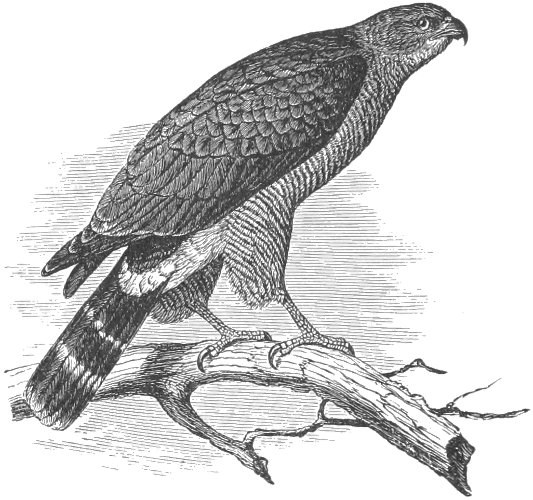
Asturina plagiata.
Mr. Robert Ridgway has met with this Hawk as far to the north as Southern Illinois. It was seen and twice shot at on the 19th of August, 1871, on Fox Prairie, in Richland County. Mr. Ridgway came across it while hunting Swallow-tail and Mississippi Kites. The bird, while being annoyed by these Hawks, was well seen, and there cannot be the slightest doubt as to its identity.
Mr. Robert Owen found this Hawk, known in Guatemala by the local name of Gavilan, a common name for the whole race of birds of prey, breeding at San Geronimo, April 3, 1860. The nests are usually found in the high trees which are scattered over the plain, and not unfrequently within a few yards of the Indian ranchos. Two eggs seemed to be the complement laid by one bird. These eggs are described by Mr. Owen as all white, without any natural coloring. The inner coating of the shell is sea-green, seeming to confirm the apparently close connection between the genera of Astur and Asturina.
Mr. G. C. Taylor met what he presumed to be this Hawk in great abundance at Comayagua, Honduras, in January. He saw a pair making their nest on the top of a lofty cotton-tree.
Captain Bendire found this species not uncommon and breeding in the vicinity of Tucson, in Arizona. He found two nests, one of which was taken June 6, the other a few days later. They were very slightly built of sticks and strips of bark, and placed in low trees on the banks of Reledo Creek. The nest contained two eggs. These are of a rounded oval shape, are quite tapering at one end and rounded at the other. They are of a uniform bluish-white color and unspotted, and measure 2.00 inches in length by 1.60 inches in breadth.
Genus ANTENOR, Ridgway
Antenor, Ridgway. (Type, Falco harrisi, Aud.)
Craxirex, Authors, not of Gould.85

42559, ♀. ¼
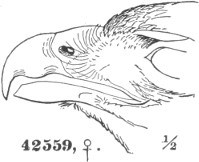
42559, ♀. ½
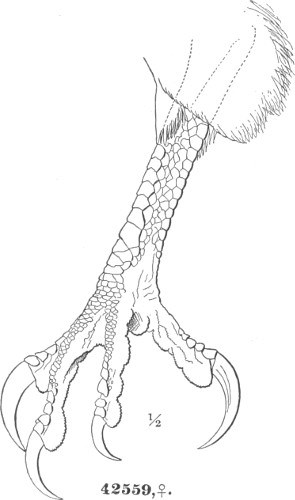
42559, ♀. ½
Parabuteo harrisi.
Gen. Char. Similar to Asturina, but form heavier, the bill and wings more elongated, the tail slightly rounded, and the lores almost naked. Bill very much as in Asturina, but more elongated, the top of the cere longer in proportion to the culmen, and the commissural lobe more anterior; the upper and lower outlines more nearly parallel. Nostril oval, horizontal, with an exposed cartilaginous tubercle. Lores nearly naked, with scant bristles. Wing long (much as in Buteo); the fourth or fifth quill longest, and the first shorter than the eighth to the tenth; outer four with inner webs sinuated. Tail long, more than two thirds the wing; even or slightly rounded. Feet robust, when outstretched reaching nearly to the end of the tail; tarsus nearly twice the length of the middle, very robust, the frontal and posterior rows of scutellæ very distinct; outer toe longer than the inner; claws strong, well curved, and acute. Sexes alike; young and old plumages very different.
This genus includes a single species, the P. unicinctus, with its two climatic races, unicinctus of South America and harrisi of Middle America. It is most nearly related to the genus Urubitinga, of tropical America, the species of which are sluggish and almost Caracara-like in their habits, though they are hardly more so than our own Buteones. The genus Craxirex of Gould having been founded upon Buteo galapagoensis, a species strictly congeneric with B. borealis, it is necessary that a new generic name should be instituted for the present species, since it so well merits separation to that rank. I accordingly propose the name given at the head of this chapter.
Species and RacesP. unicinctus. Wing, 11.65–14.60; tail, 9.00–11.00; culmen, .82–1.10; tarsus, 2.78–3.75; middle toe, 1.52–2.00. Adult. General color brownish-black or blackish-brown, uniform, or slightly variegated by light spotting; the lesser wing-coverts and tibiæ deep rufous, or chestnut. Tail black; the end and base white, as are also the tail-coverts. Young. Plumage greatly variegated. Above blackish-brown, the feathers edged with rusty; head and neck streaked with pale ochraceous. Lower parts pale ochraceous or yellowish-white, the breast and abdomen with longitudinal ovoid spots of blackish; tibiæ with transverse bars of dark rusty; lower tail-coverts with black shaft-streaks. Lesser wing-covert region only washed with rufous. Tail grayish-brown, whitish at the tip, and crossed by narrow bands of dusky.
Adult with the blackish much broken up by lighter spotting. Wing, 11.65–14.60; tail, 9.00–10.50; culmen, .82–1.02; tarsus, 2.78–3.40; middle toe, 1.52–1.85. Hab. South America … var. unicinctus.86
Adult with the blackish continuous and uniform. Wing, 12.35–14.50; tail, 9.80–11.00; culmen, .90–1.10; tarsus, 3.15–3.75; middle toe, 1.65–2.00. Hab. Middle America, north into southern border of United States … var. harrisi.
Parabuteo unicinctus, var. harrisi (Ridgway)HARRIS’S BUZZARDFalco harrisi, Aud. B. Am. pl. cccxcii, 1831.—Ib. Orn. Biog. V, 30. Buteo harrisi, Aud. Synop. 1839, 5.—Bonap. List, 3.—De Kay, Zoöl. N. Y. II, 11.—Craxirex unicinctus, var. harrisi, Ridgway, P. A. N. S. Philad. Dec. 1870, p. 142. Buteo unicinctus, var. harrisi, Coues, Key, 1872, 215. “Craxirex unicinctus, Temm.” Cass. Birds N. Am. 1858, 46.—Dresser, Ibis, 1865, 329 (Texas).—Coues, P. A. N. S. 1866, 13 (Arizona).
Sp. Char. Adult male (17,230, Cape St. Lucas, Lower California; J. Xantus). General plumage uniform sooty-black, purest on the tail, somewhat tinged with chestnut on the rump. Lesser wing-coverts and lateral half of each web of middle coverts, also the tibiæ, rich deep chestnut, perfectly uniform. Upper and lower tail-coverts, and broad basal and terminal zones of tail, pure white, the anterior band concealed (except on outer feathers) by the upper coverts, and about twice the width of the last, which is about 1 inch wide. Tail-coverts with a few irregular narrow shaft-streaks of blackish. Lining of wing deep chestnut, like the shoulders; each greater covert with a black shaft-streak; primaries beneath plain black. Wing, 14.50; tail, 10.00; tarsus, 3.25; middle toe, 2.00. Fourth and fifth quills longest and equal; third considerably shorter; second intermediate between sixth and seventh; first 3.40 shorter than longest.
Adult female (42,559, Iztlan, Mexico; Colonel Grayson). Generally similar to the male; the black, however, less pure and more brownish, the chestnut more extended, the whole rump being of this color, the last feathers merely being blackish in the middle. White of tail-coverts without blackish streaks. Wing, 14.60; tail, 10.30; tarsus, 3.25; middle toe, 1.95.
Immature male (second year, 50,763, Tepic, Mexico; Colonel Grayson). Upper parts similar to adult, but less uniform; the nape and back with feathers edged with rusty; sides of head and neck very much streaked. Breast and abdomen light ochraceous, with large longitudinal oval spots of black; tibiæ light ochraceous, with rather distant transverse bars of dark rusty-brown; lower tail-coverts ochraceous-white, with black shaft-lines. Rufous on the wings more extended and more broken; none on the rump. Terminal band of tail narrower and less sharply defined than in adult; inner webs of primaries with basal two-thirds white, irregularly mottled with dusky. “Iris chestnut-brown; cere, chin, and space round the eyes yellow.”
Immature female (second year, 15,260, Fort Buchanan, New Mexico; Dr. Irwin). Black spots beneath larger and more irregularly defined; tibiæ strongly barred with dark rufous; posterior edge of basal band of tail much broken.
Hab. Middle, or northern tropical, America, from the Isthmus of Panama northward into the southern United States; Mississippi (Audubon); Texas (Mus. S. I.; Dresser); Arizona (Coues).
Localities: Guatemala (Scl. Ibis, I, 216).
LIST OF SPECIMENS EXAMINEDNational Museum, 13; Philadelphia Academy, 3; Cab. G. N. Lawrence, 2; Coll. R. Ridgway, 1. Total, 19.

Habits. This Hawk has a very limited range within the United States, and Mr. Audubon, who was the first to meet with it there, obtained only a single specimen from Louisiana. Supposing it to be an undescribed species, he named it in honor of his friend, Mr. Edward Harris.
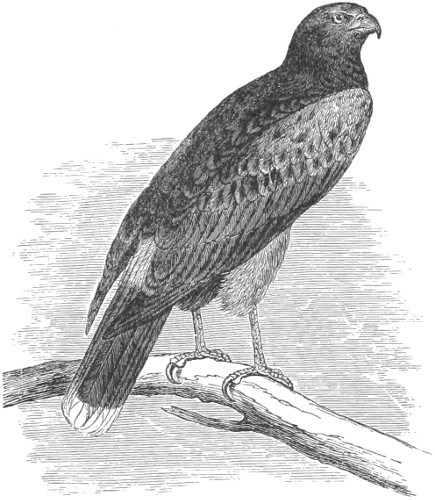
Parabuteo harrisi.
This species is occasionally found in the lower portions of the States of Mississippi and Louisiana, but becomes much more abundant in the southwestern sections of the latter State, and in Texas is common, especially about the mouth of the Rio Grande. In one variety or the other it is frequently met with throughout Mexico, and Central America, and is also said to be an occasional visitant of Cuba and Jamaica.
Mr. Dresser found this Hawk common throughout Texas to the Colorado River, beyond which he noticed but few. It was the only Hawk he noticed at Matamoras in the summer. He describes it as a heavy, sluggish bird, seldom seen on the wing, and subsisting, so far as he could see, entirely on carrion. All along the road from Brownsville to San Antonio, he noticed it either perched on some tree by the roadside, or busy, in company with Vultures and Caracaras, regaling on some offensive carrion. He found it breeding in the neighborhood of San Antonio, Medina, and Altascosa Rivers, having eggs in the month of May. A nest found on the 4th of May, near the Medina River, was built of sticks, very slightly lined, and was placed in a low hackberry-tree. The eggs were four in number, and described as white, with a faint bluish tinge, very sparingly spotted and blotched with red.
Other writers also agree in representing this Hawk as heavy and sluggish in habit, and as frequenting streams of water, and its food as consisting chiefly of the reptiles and smaller animals which frequent the banks of rivers and creeks. It builds its nests on low trees, in the immediate vicinity of its hunting-ground, and often over the water, constructing them of coarse flags and water-plants. The nests are usually not very large for the birds, are flattened or with very slight depressions, and the materials are very loosely put together. The eggs are from three to five in number, usually white and unspotted, occasionally with more or less of a yellowish or tawny tinge. In some instances they are faintly marked with light dashes or stains of a yellowish-brown, and, more rarely, are also marked with small blotches of sepia-brown, and with smaller dottings of purplish-drab. Their average measurement is, length 2.13, breadth 1.69 inches.
Our knowledge of the eggs of these Hawks is derived from the collection of the late Dr. Berlandier, of Matamoras, in the Province of Tamaulipas, Mexico. In the cabinet of that gentleman were several varieties, now in the possession of the Smithsonian Institution, and presented to it by Lieutenant Couch.
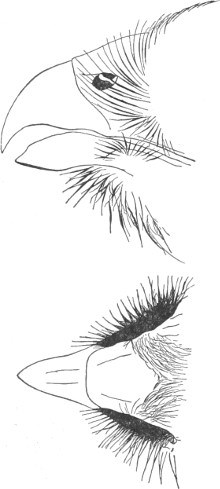
Onychotes gruberi, Type, (41703. California.)
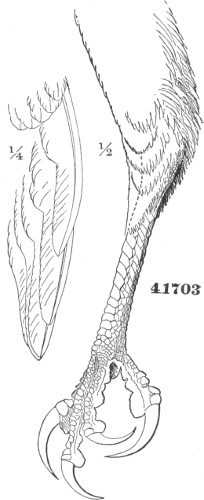
41703 ¼ ½
Onychotes gruberi.
Genus ONYCHOTES, Ridgway
Onychotes, Ridgway, P. A. N. S. Philad. Dec. 1870, 142. (Type, O. gruberi, nov. sp.)
Gen. Char. Bill short, the tip remarkably short and obtuse, and only gradually bent; cere on top about equal to the culmen, very broad basally in its transverse diameter, and ascending, in its lateral outline, on a line with the culmen; commissure only faintly lobed. Nostril nearly circular, with a conspicuous (but not central or bony) tubercle; cere densely bristled below the nostril, almost to its anterior edge; orbital region finely bristled. Tarsus very long and slender, nearly twice the length of the middle toe; toes moderate, the outer one decidedly longer than the inner; claws very long, strong, and sharp, and curved in about one quarter the circumference of a circle. Tibial feathers short and close, the plumes scarcely reaching below the joint. Feathers of the forehead, gular region, sides, and tibiæ, with white filamentous attachments to the end of the shafts. Wing very short, much rounded, and very concave beneath; fourth quill longest; first shorter than ninth; four primaries emarginated, and one sinuated, on inner webs; five sinuated on outer webs. Tail about two thirds as long as wing, rounded. Outstretched feet reaching beyond end of tail.
This genus has no very near relatives among the American Falconidæ, nor, indeed, among those of other portions of the world. It is, perhaps, most closely related to the genus Rupornis, of South America, from which, however, it is very distinct. It is represented by a single species, the type of which, supposed to have come from California, still remains unique.
The elongated legs, reaching considerably beyond the rather short tail, the close thigh-plumes, the long and extremely acute claws (somewhat like those of Rostrhamus), with the short, rounded, and very concave wing, are its most striking peculiarities. Besides these distinguishing features, the short, thick bill, very deep through the base, and the filamentous attachments to the shafts of the feathers of certain parts of the body, are also very characteristic. The latter feature may possibly be a mark of immaturity, but I have seen nothing like it in other Raptores, and it seems to be more analogous to the nuptial ornaments seen in the Cormorants (Phalocrocoracidæ).


